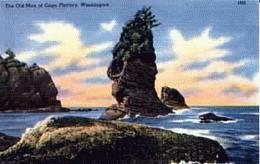On January 31, 1855, at Neah Bay near Cape Flattery at the tip of the Olympic Peninsula, 42 Makah leaders sign a treaty with Isaac Stevens (1818-1862), governor and Superintendent of Indian Affairs of Washington Territory. The leaders, representing four of the five traditional Makah villages, give up most of their ancestral lands, keeping only a small reservation at Cape Flattery, in return for a promised $30,000 in annuity payments and a guarantee of the right of hunting, fishing, sealing, and whaling.
The Treaty of Neah Bay followed treaties that Gov. Stevens made with Indians on Puget Sound in December 1854 and January 1855 at Medicine Creek in present-day Thurston County, Point Elliott (now Mukilteo), and Point No Point (near Hansville on the Kitsap Peninsula).
The Treaty of Neah Bay, signed by leaders from the Makah villages at Neah, Wyaach, Tsooes, and Ozette gave up almost all the Makah lands, described in the treaty as extending from Cape Flattery along the Strait of Juan de Fuca to the Hoko River some 15-20 miles east, and from Cape Flattery along the Pacific Ocean to Ozette and Cape Alava about 15 miles south. The reservation provided for in the treaty encompassed only the immediate vicinity of Cape Flattery and did not initially include the traditional villages except for Neah. It was subsequently enlarged to approximately 27,000 acres.
Unlike some treaties that Stevens signed, the Treaty of Neah Bay did not lead to armed conflict between the United States and the Makah. However, the "right of taking fish and of whaling or sealing at usual and accustomed grounds and stations," set forth in Article 4 of the Treaty, has been the subject of numerous legal battles, beginning in the late 1800s and still going on in the second decade of the twenty-first century, more than 150 years after the Treaty was signed. The guarantee of hunting and fishing rights in Article 4 is also found in the other treaties Stevens signed, but the Treaty of Neah Bay is the only treaty signed by the United States that guarantees the right of whaling.

